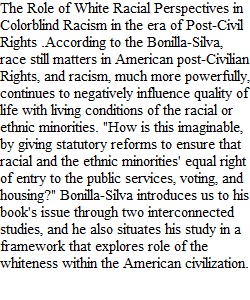


Q Students are required to write a 4-6 page, double-spaced paper discussing the below listed elements from Racism Without Racists, and make connections to materials covered in this class. This is not a book review, nor is it a summary of the entire book. Rather, the requirement is for students to discuss and analyze the following topics found in various chapters of Eduard Bonilla-Silva's Racism Without Racists: -What is colorblind racism? What does Bonilla-Silva mean when he says racism without racists? -What is the "new racism" since the 1960s? -What is cultural racism, and how does that differ from institutional racism? -What tactics do people use to not sound "nasty," but still be racist? To answer this, fully investigate chapter 4. Provide at least three tactics that people do this. -How much progress has been made in the US on race? What does Bonilla-Silva argue? Add in some detail from a historical event covered in class. -Fully investigate chapter 10. Summarize the racial tone, policies, and experiences in America from Obama to trump. -Lastly, what role do YOU play in the racial narrative? That is, in what ways can YOU change the dynamics? How can YOU change it? (Chapter 11) Technicalities: • DUE Wednesday, March 30th at 11:59 PM. • Size 12 font, double spaced, standard margins, a minimum of 4 pages, but please write as much as you feel you need to answer the questions. • The paper is a cohesive essay, with an introduction, body paragraphs, and a conclusion. Some paragraphs and discussions will be longer than others and/or will require more detail and writing than others. That is fine. • The paper is NOT about whether you agree or disagree. I appreciate your opinion, but that is not the type of paper you are required to write. This is a critical reflection and analysis of the text. • Please make your paper strong by using some direct quotes, and/or paraphrasing some of the material. This being said, however, please ensure that most of the paper is in your own words. If you use quotes from the book, three rules: 1. cite the material with quotes and end parenthesis and 2. limit direct quotes to 3-4 per page, 3. do not use more than 2 block quotes in your entire paper. For more info on how to properly cite, please visit: MLA Citing Guide- Purdue University (Links to an external site.) • Student submissions will automatically be checked by the Mt. SAC plagiarism system, Unicheck. Any submissions surpassing 19.0% in plagiarism scoring will automatically receive a zero. To avoid this, please just properly cite! Important Notes: • The book is available as a PDF under the "Modules" tab, and is labeled Racism Without Racists PDF • Although the answers to these questions are spread throughout the book, most of what I am asking students to investigate, understand, and write on are from chapters 1-4, and chapters 10 and 11. I say this to you so that you don't feel overwhelmed with the assignment. You can find most of what you need in these chapters. Of course, I highly recommend students read the entire book, as it is of upmost importance for us, especially in the socio-political and cultural climate we have been in the last four years. However, you do not need to read the entire book to successfully answer the prompt questions. • Some of the questions found above in the bullet points are simply restated in another way. Do not feel the need to cover it twice if you already covered a question. For example, I ask about cultural racism, but if you would like to cover that as one of the three tactics used, that's fine, you don't need to write on it twice. • If you have any questions, please do not hesitate to ask. I am here to help. :)
View Related Questions